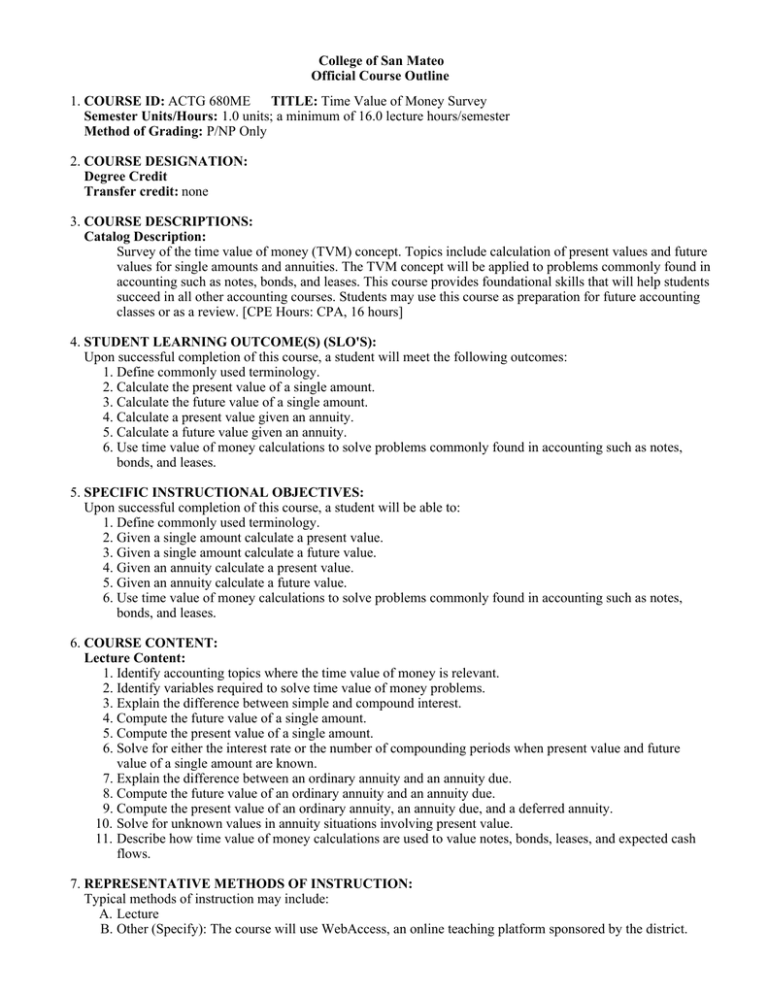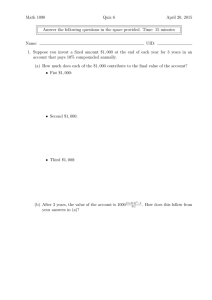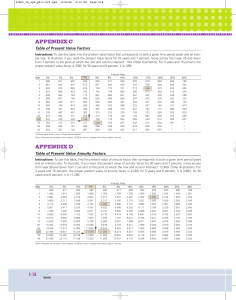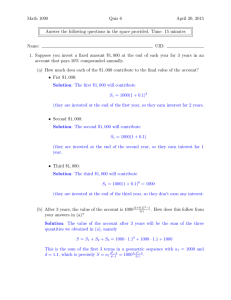College of San Mateo Official Course Outline COURSE ID: Semester Units/Hours:
advertisement

College of San Mateo Official Course Outline 1. COURSE ID: ACTG 680ME TITLE: Time Value of Money Survey Semester Units/Hours: 1.0 units; a minimum of 16.0 lecture hours/semester Method of Grading: P/NP Only 2. COURSE DESIGNATION: Degree Credit Transfer credit: none 3. COURSE DESCRIPTIONS: Catalog Description: Survey of the time value of money (TVM) concept. Topics include calculation of present values and future values for single amounts and annuities. The TVM concept will be applied to problems commonly found in accounting such as notes, bonds, and leases. This course provides foundational skills that will help students succeed in all other accounting courses. Students may use this course as preparation for future accounting classes or as a review. [CPE Hours: CPA, 16 hours] 4. STUDENT LEARNING OUTCOME(S) (SLO'S): Upon successful completion of this course, a student will meet the following outcomes: 1. Define commonly used terminology. 2. Calculate the present value of a single amount. 3. Calculate the future value of a single amount. 4. Calculate a present value given an annuity. 5. Calculate a future value given an annuity. 6. Use time value of money calculations to solve problems commonly found in accounting such as notes, bonds, and leases. 5. SPECIFIC INSTRUCTIONAL OBJECTIVES: Upon successful completion of this course, a student will be able to: 1. Define commonly used terminology. 2. Given a single amount calculate a present value. 3. Given a single amount calculate a future value. 4. Given an annuity calculate a present value. 5. Given an annuity calculate a future value. 6. Use time value of money calculations to solve problems commonly found in accounting such as notes, bonds, and leases. 6. COURSE CONTENT: Lecture Content: 1. Identify accounting topics where the time value of money is relevant. 2. Identify variables required to solve time value of money problems. 3. Explain the difference between simple and compound interest. 4. Compute the future value of a single amount. 5. Compute the present value of a single amount. 6. Solve for either the interest rate or the number of compounding periods when present value and future value of a single amount are known. 7. Explain the difference between an ordinary annuity and an annuity due. 8. Compute the future value of an ordinary annuity and an annuity due. 9. Compute the present value of an ordinary annuity, an annuity due, and a deferred annuity. 10. Solve for unknown values in annuity situations involving present value. 11. Describe how time value of money calculations are used to value notes, bonds, leases, and expected cash flows. 7. REPRESENTATIVE METHODS OF INSTRUCTION: Typical methods of instruction may include: A. Lecture B. Other (Specify): The course will use WebAccess, an online teaching platform sponsored by the district. Through WebAccess and related resources the course may use online presentations, bulletin boards, Through WebAccess and related resources the course may use online presentations, bulletin boards, resource links, chat rooms, forums, office hours, and email. Announcements and weekly postings are typically done at the start of the week and more often when necessary. 8. REPRESENTATIVE ASSIGNMENTS Representative assignments in this course may include, but are not limited to the following: Writing Assignments: Students will complete a series of essay assignments on the following topics: Define the terminology commonly used in time value of money calculations. Describe the steps required to solve a time value of money problem. Explain when time value of money calculations are required. Compare and contrast simple interest and compound interest. Explain how to solve present value problems. Explain how to solve future value problems. Compare and contrast an ordinary annuity and an annuity due. Reading Assignments: A. Read textbook. B. Read online resources provided by instructor on WebAccess. 9. REPRESENTATIVE METHODS OF EVALUATION Representative methods of evaluation may include: A. Exams/Tests B. Homework C. Quizzes 10. REPRESENTATIVE TEXT(S): Possible textbooks include: A. Horngren/Sundem/Elliott/Philbrick. Introduction to Financial Accounting, 11 ed. Pearson, 2014 Possible software includes: A. MyAccountingLab. Pearson, 11th, 2014 ed. To accompany: Introduction to Financial Accounting Horngren/Sundem/Elliott/Philbrick Origination Date: March 2014 Curriculum Committee Approval Date: April 2014 Effective Term: Fall 2014 Course Originator: Bruce Maule







